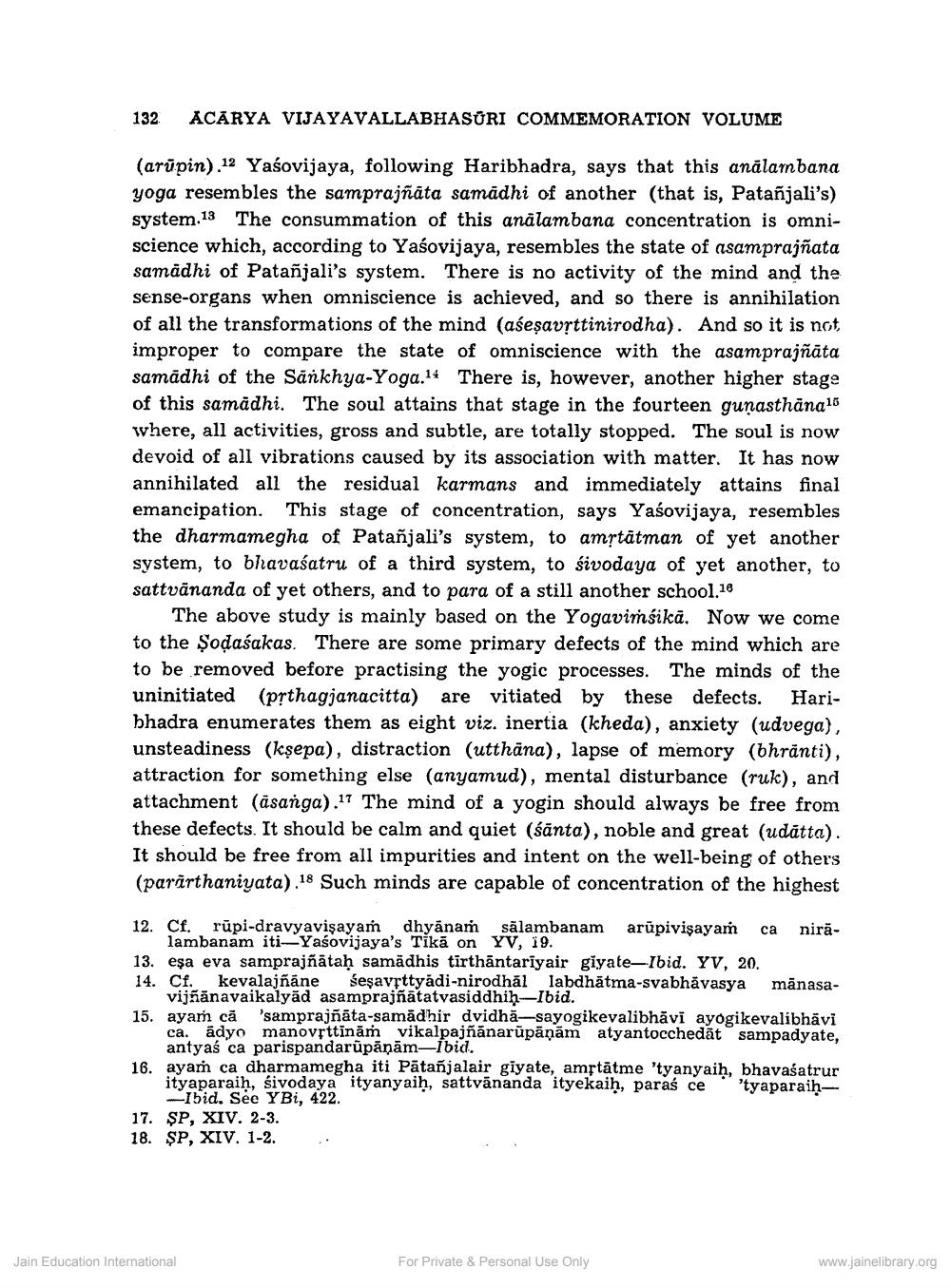Book Title: Acarya Haribhadras Comparative Studies in Yoga Author(s): Nathmal Tatia Publisher: Z_Vijay_Vallabh_suri_Smarak_Granth_012060.pdf View full book textPage 4
________________ 132 ACARYA VIJAYAVALLABHASURI COMMEMORATION VOLUME (arūpin), Yasovijaya, following Haribhadra, says that this anālambana yoga resembles the samprajñāta samadhi of another (that is, Patanjali's) system. The consummation of this analambana concentration is omniscience which, according to Yasovijaya, resembles the state of asamprajñata samadhi of Patanjali's system. There is no activity of the mind and the sense-organs when omniscience is achieved, and so there is annihilation of all the transformations of the mind (aseṣavṛttinirodha). And so it is not improper to compare the state of omniscience with the asamprajñāta samadhi of the Sankhya-Yoga.14 There is, however, another higher stage. of this samadhi. The soul attains that stage in the fourteen guṇasthäna where, all activities, gross and subtle, are totally stopped. The soul is now devoid of all vibrations caused by its association with matter. It has now annihilated all the residual karmans and immediately attains final emancipation. This stage of concentration, says Yasovijaya, resembles the dharmamegha of Patanjali's system, to amṛtātman of yet another system, to bhavaśatru of a third system, to sivodaya of yet another, to sattvänanda of yet others, and to para of a still another school.20 The above study is mainly based on the Yogavimsika. Now we come. to the Sodasakas. There are some primary defects of the mind which are to be removed before practising the yogic processes. The minds of the uninitiated (pṛthagjanacitta) are vitiated by these defects. Haribhadra enumerates them as eight viz. inertia (kheda), anxiety (udvega), unsteadiness (ksepa), distraction (utthäna), lapse of memory (bhränti), attraction for something else (anyamud), mental disturbance (ruk), and attachment (asanga). The mind of a yogin should always be free from these defects. It should be calm and quiet (sänta), noble and great (udatta). It should be free from all impurities and intent on the well-being of others (pararthaniyata).18 Such minds are capable of concentration of the highest 12. Cf. rupi-dravyavişayam dhyanam sālambanam arupivişayam ca nirälambanam iti-Yasovijaya's Tikā on YV, 19. 13. eşa eva samprajñātaḥ samadhis tīrthāntariyair giyate-Ibid. YV, 20. 14. Cf. kevalajñāne Seşavṛttyādi-nirodhal labdhātma-svabhāvasya mānasavijñānavaikalyād asamprajñātatvasiddhiḥ-Ibid. 15. ayam că 'samprajñāta-samadhir dvidha-sayogikevalibhavi ayogikevalibhāvi ca. adyo manovṛttinām vikalpajñānarūpāņām atyantocchedāt sampadyate, antyaś ca parispandarūpāņām-Ibid. 16. ayam ca dharmamegha iti Pātañjalair giyate, amṛtātme 'tyanyaiḥ, bhavaśatrur ityaparaiḥ, śivodaya ityanyaiḥ, sattvānanda ityekaiḥ, paras ce 'tyaparaih-Ibid. See YBi, 422. 17. SP, XIV. 2-3. 18. SP, XIV. 1-2. Jain Education International For Private & Personal Use Only www.jainelibrary.orgPage Navigation
1 2 3 4 5 6 7 8 9 10 11 12 13 14
